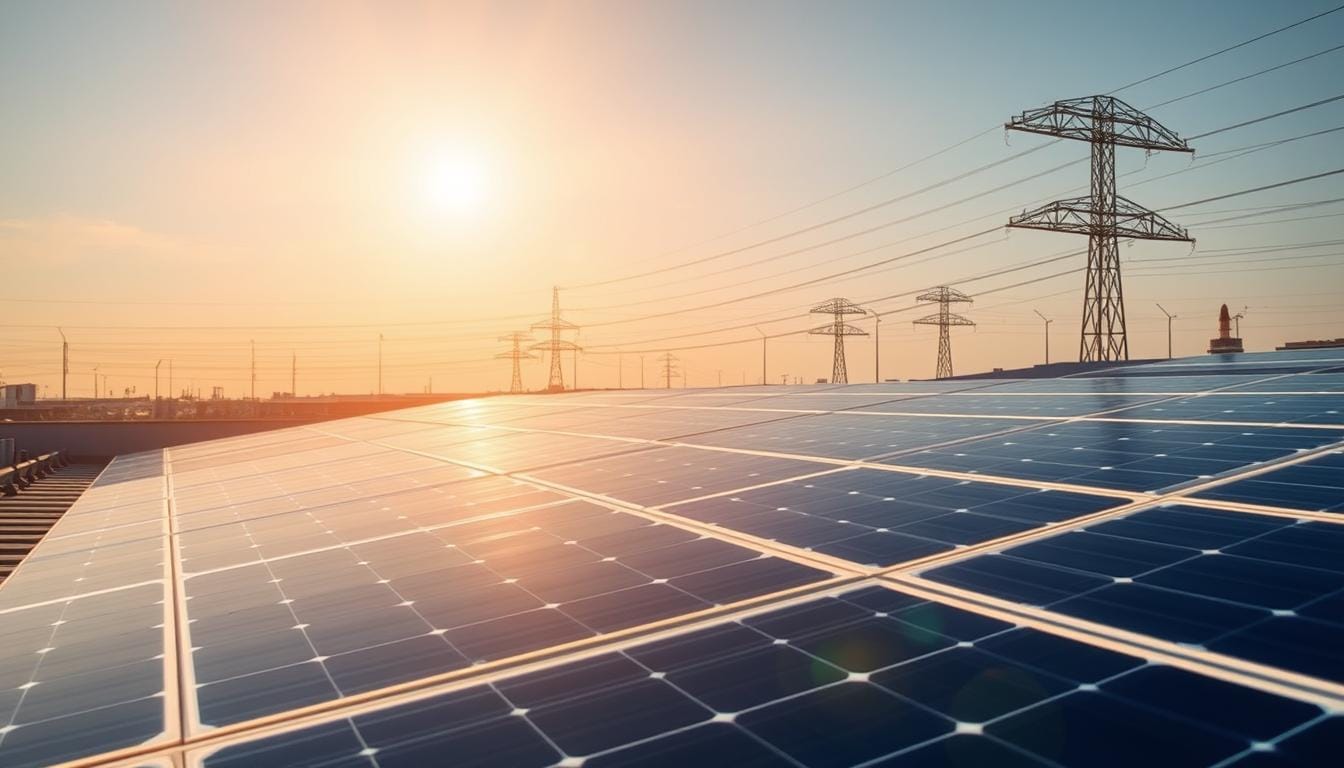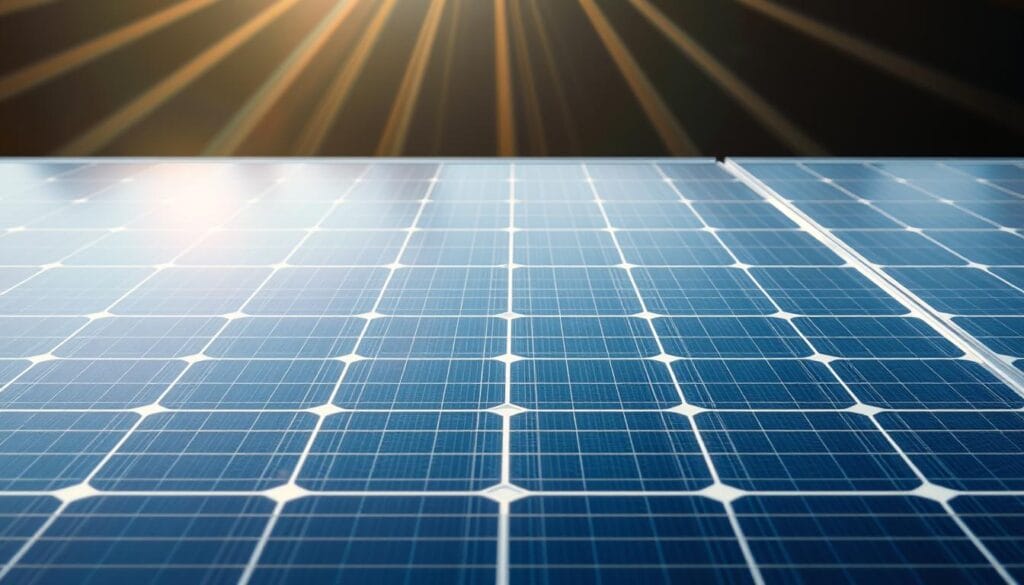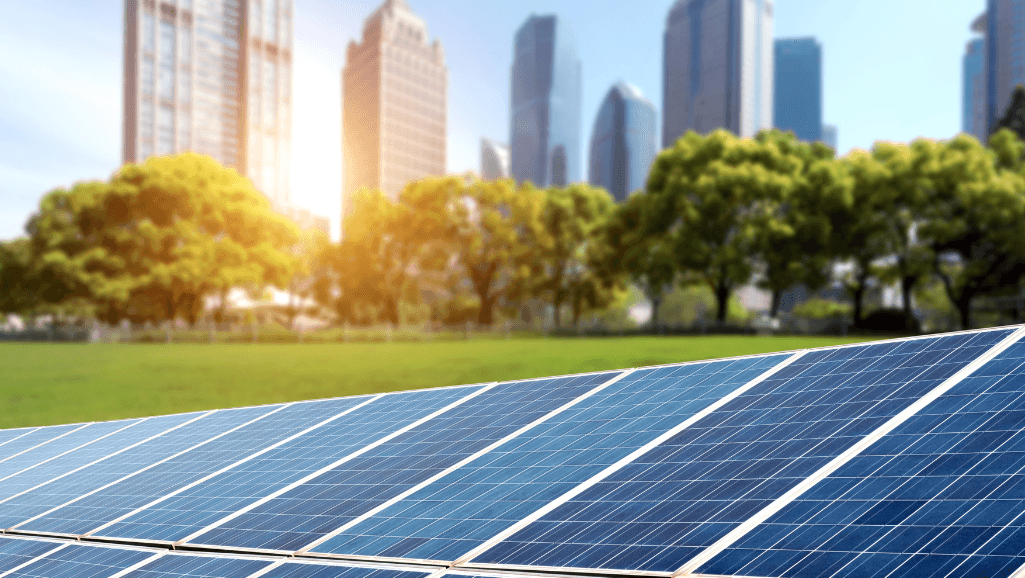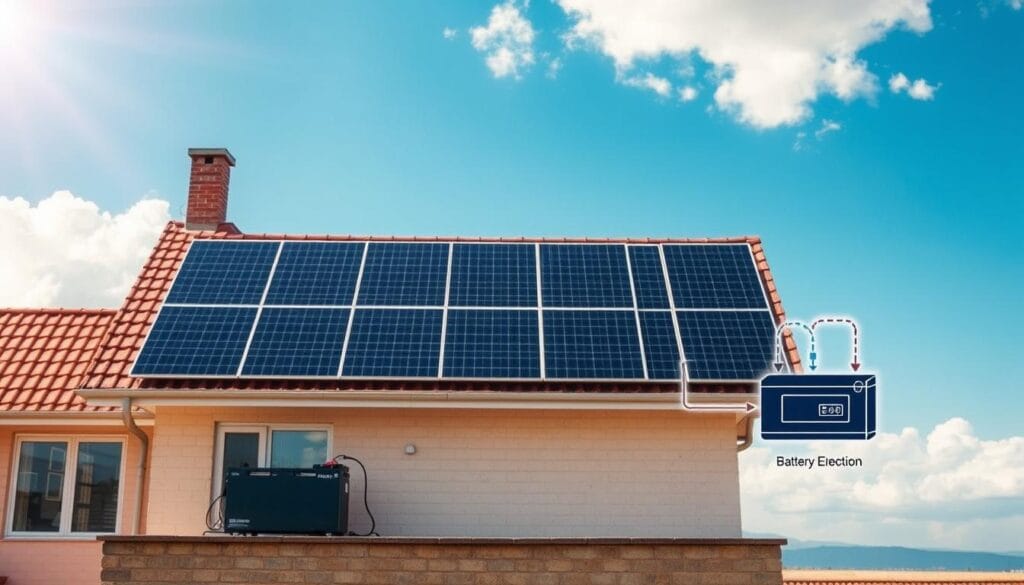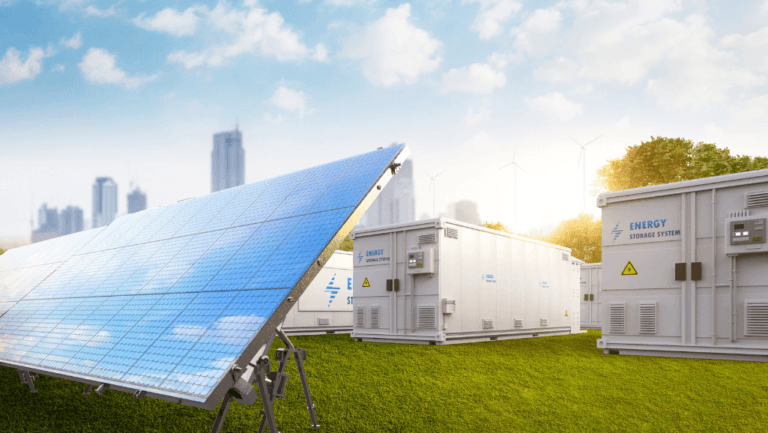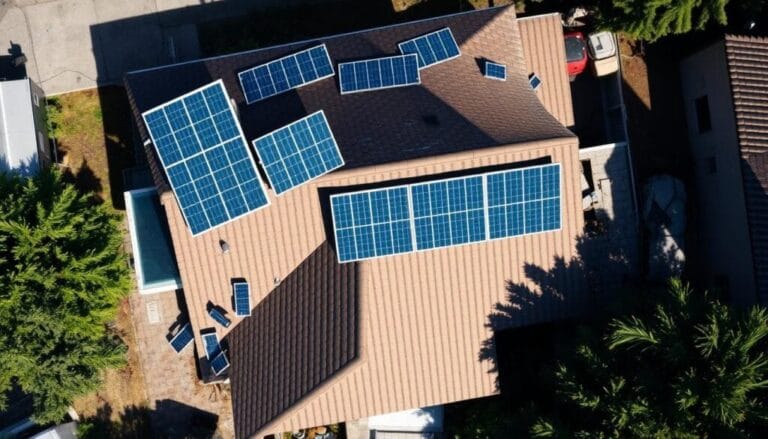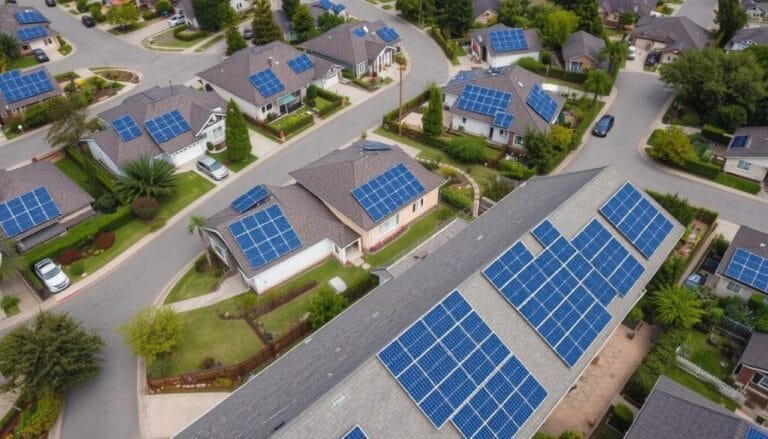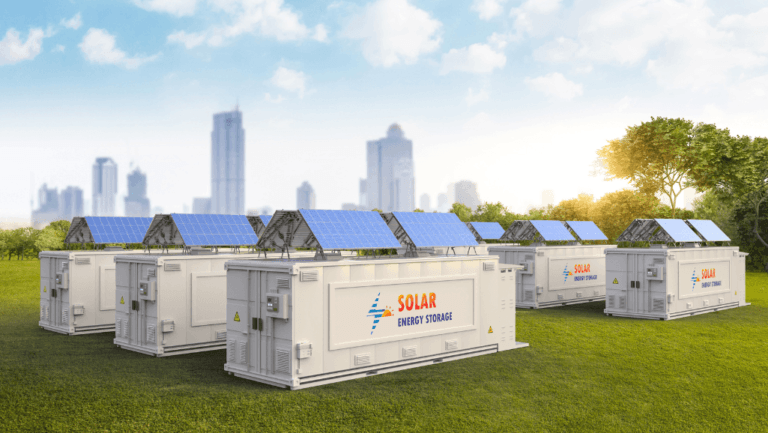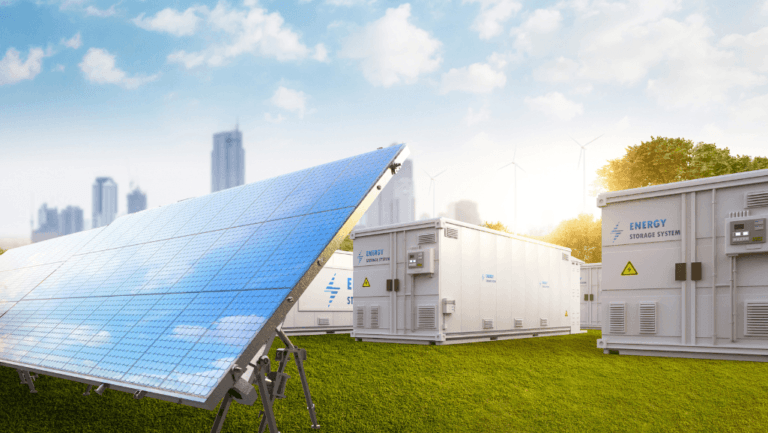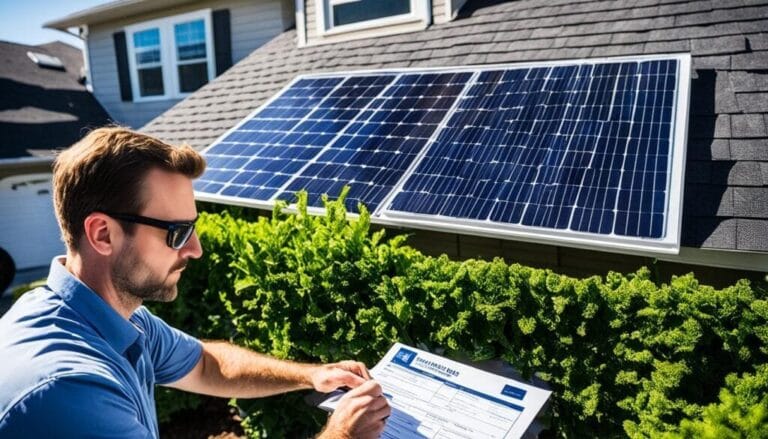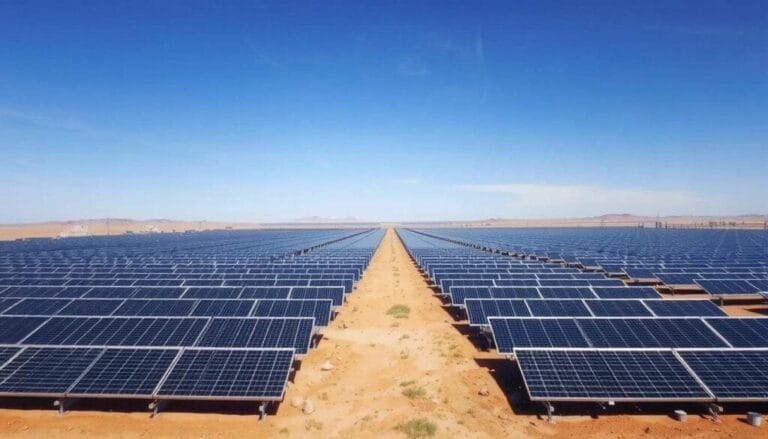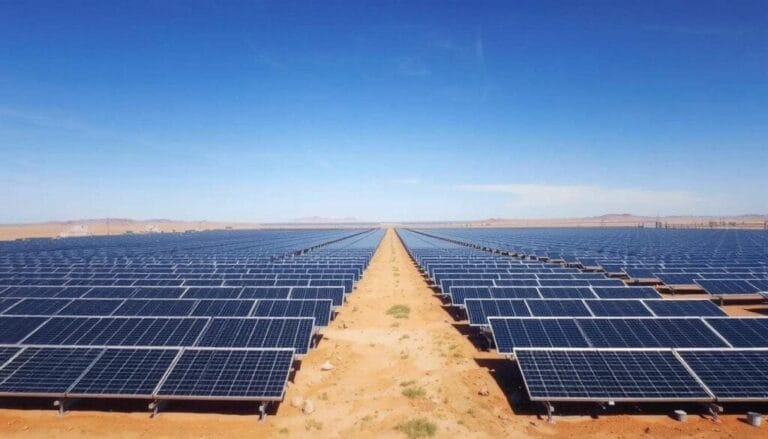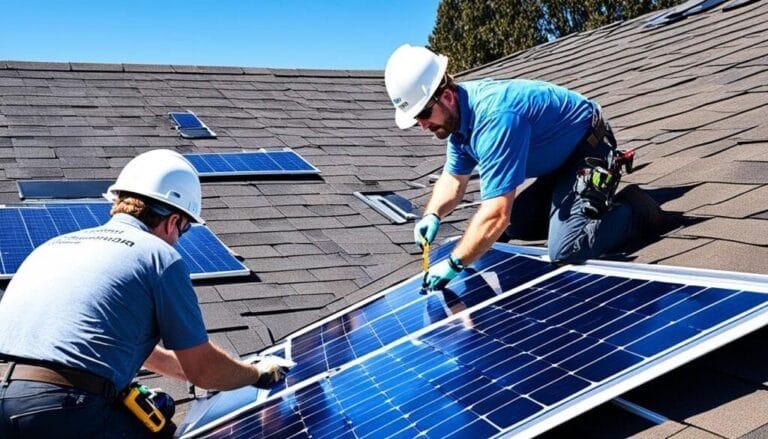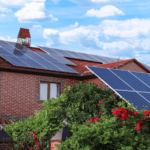Solar energy is becoming a key solution for our planet’s future. It uses sunlight, the most abundant resource we have. From just 0.06 trillion British thermal units (Btu) in 1984, the U.S. now uses 1,870 trillion Btu of solar energy. This shows how solar power has grown and become more efficient.
Homeowners are now turning to solar power to save money and make their homes more energy efficient. Photovoltaic (PV) systems have played a big role in this growth. They’ve helped increase solar electricity in the U.S. from 5 million kWh in 1984 to 204 billion kWh in 2022. This shows how better technology and a focus on renewable energy are making solar power more important.
Key Takeaways
- how is electricity produced using solar power.
- Transformative growth in solar power usage evidenced by statistics on energy consumption.
- Significance of solar panel electricity production within the portfolio of renewable energy technologies.
- Striking advancements in the efficiency of photovoltaic systems contributing to solar energy’s feasibility.
- Integration of solar technology with energy systems to enhance environmental sustainability and reduce dependence on non-renewable sources.
- Continued innovation and declining costs poised to accelerate the adoption of solar energy globally.
The Power of The Sun: Unlimited Potential for Electricity Production
Solar power uses the sun’s vast energy to make electricity. This happens through technologies like photovoltaics and concentrating solar-thermal power. At the sun’s core, about 620 million metric tons of hydrogen fuse every second. This shows how much solar energy we can use.
The Science Behind Solar Radiation and Its Utilization
About 30 percent of solar energy is reflected back into space. But most of it is absorbed by our planet. This energy is key for nature and technology. For instance, the SEGS in California’s Mojave Desert uses mirrors to focus solar energy. This makes a lot of electricity every year.
Technologies like Fresnel reflectors can boost the sun’s energy by up to 30 times. This shows how concentrating solar-thermal power can manage and use solar radiation well.
Understanding Photovoltaic Systems and Their Growth
Photovoltaic technology started in 1839 with Alexandre-Edmond Becquerel’s discovery. Since then, photovoltaics growth has grown fast. For example, the International Space Station uses solar arrays for power.
Solar panels have become more affordable, dropping by over 70% in the last decade. This has made them popular in homes, businesses, and industries.
The Solar Energy Generating System in California is a great example of solar power’s potential. It uses concentrated solar power to make a lot of electricity.
| Energy Source | Annual Output (GWh) |
|---|---|
| Solar Energy Generating System (CSP) | 650 |
| International Space Station (Photovoltaic) | Dependent on solar exposure |
The efficiency of solar energy systems changes with the weather and time. But solar power could meet all the world’s energy needs in just one hour of sunlight.
This green energy source is key for the future. It can greatly cut down on greenhouse gases and use solar energy fully.
how is electricity produced using solar power
Solar power systems turn sunlight into electrical energy with the help of technology. They use light to power homes and businesses, helping us move towards a sustainable future. A key part of this is solar photovoltaic electricity generation. It uses special materials to catch and change sunlight into electricity.
The Journey from Sunlight to Power Grid
Solar photovoltaic (PV) systems start by catching sunlight with solar panels made of silicon. These panels grab energy when the sun is strongest to work best. The sunlight makes electrons in the silicon move, creating an electric field that lets electricity flow.
This electricity is DC but needs to be changed to AC to work in our homes and devices. Inverters do this job, turning DC into AC.
There are two types of inverters for solar power systems. They can be one big unit or many small ones, placed behind each panel. This setup makes the power more reliable and efficient.
The Role of Semiconductor Materials in PV Cells
Thin silicon wafers with two layers are key for making electricity. One layer is positive, the other negative. When sunlight hits them, it messes with the flow of electrons, making electricity.
This power can be used in our homes or sent back to the grid through net metering. Net metering tracks the flow of electricity, giving credits for extra power made and sent to the grid.
| Component | Function | Details |
|---|---|---|
| Silicon Cells | Light absorption | Absorb sunlight, create electron movement |
| Inverters | Conversion to AC | Convert DC electricity to AC for home use |
| Net Metering | Measurement and credits | Measures in and out-flow of electricity, credits surplus energy |
Learning about how solar power works shows us how important semiconductor materials are. They make solar PV systems work well, showing us how solar energy can give us a lot of our electricity.
Maximizing Efficiency in Solar Panels
Improving solar panel efficiency is key to getting more energy and saving money and the planet. Using new methods and keeping up with maintenance helps a lot. This makes solar energy better.
High-efficiency solar panels turn about 20% of sunlight into electricity, beating standard panels. New tech like solar concentrators uses mirrors to focus sunlight, making more power.
Where you put solar panels matters a lot. In the U.S., pointing them south gets the most sunlight. Solar trackers that move with the sun can also increase power a lot.
Keeping solar panels clean is important. Dust can cut efficiency by up to 25%. Cleaning them often, especially in dusty places, helps. Also, make sure panels don’t get shadowed to keep them working well.
Smart home tech and energy management can make solar even better. Using energy wisely cuts down on grid power use and boosts solar efficiency. Here’s a guide on maintaining solar panels for better efficiency and life.
Here’s how different things affect solar panel efficiency:
| Factor | Impact on Efficiency | Mitigation Strategy |
|---|---|---|
| High-efficiency panels | Converts 20% of sunlight | Install advanced PV cells like monocrystalline silicon |
| Dirt and debris | Reduces efficiency by up to 25% | Regular cleaning, more frequently in dusty areas |
| Shading | Significant reduction in output | Avoid installing in shaded areas |
| Energy management | Optimizes energy usage | Incorporate smart systems and schedule high-energy tasks during peak sunlight |
To keep solar panels working great, use new tech, place panels smartly, and maintain them well. By doing these things, users can make their solar systems work better and last longer.
Breakthroughs in Solar Power Technology Overview
The solar power world has changed a lot thanks to advancements in solar technology. These changes improve traditional systems and set the stage for next-generation solar solutions. These solutions will change how we use the sun’s energy.
Recent Advancements in Solar Photovoltaic Technology
Photovoltaic (PV) efficiency has grown a lot over the years. Records went from 25% in 2000 to almost 50% in recent tests. Bifacial solar panels are a big part of this growth, making up to 20% more power by catching more light.
Solar tracker technology also plays a big role, boosting energy production by up to 25%. Thin-film solar cells are another big step forward. They make solar power cheaper and available to more people.
Next-Generation Solar Solutions: A Peek into the Future
Looking ahead, we see big changes with perovskite solar cells and lower solar battery costs. These advancements in solar technology are making solar energy more efficient and affordable. They’re also leading to new uses like solar windows and solar tiles.
The future looks bright with nano PV cells that could be seven times more efficient than current ones. This shows how solar technology is set to change the world.
As we keep exploring these new solar solutions, a sustainable and energy-efficient future is within reach. It’s clear that the new solar technology could change global energy plans and cut down on non-renewable energy use.
Understanding Solar Power System Operation
The complex workings of solar power systems need deep knowledge in solar power system design basics and systems integration basics. To blend solar tech with our energy systems well, we must grasp both the parts of solar panels and how they work with the grid.
Solar panels turn sunlight into electricity through the photovoltaic effect. They use semiconductors like monocrystalline and polycrystalline silicon. These materials catch sunlight and help electrons move to make electricity.
- Monocrystalline cells are top picks for their high efficiency, thanks to their pure silicon structure.
- When the sun shines brightest, these panels work best, helping cut down energy bills.
- The inverter is key, changing the DC power from solar panels into AC for home use.
Net metering is a big plus for homes with solar power. It lets homeowners get credits for extra power made, encouraging more solar use. Solar batteries are also key, storing extra power for when the sun isn’t shining, keeping energy steady and cutting reliance on the grid.
Smart meters are vital for tracking energy use in real-time and managing power well. They help make sure energy use is smooth, boosting system reliability and performance. This is crucial for solar power system design basics.
Knowing how these parts work can make solar power systems work better, leading us toward a greener and more efficient energy future.
From Solar Array to Electricity Output: A Detailed Look
Understanding how solar arrays turn sunlight into usable power is key for getting the most out of solar systems. We look at how sunlight is captured and turned into electricity. This includes solar array electricity output and how to measure solar panel efficiency.
How Solar Arrays Capture and Convert Sunlight
Solar panels are made up of many solar cells that work together. These cells change sunlight into electricity through the photovoltaic effect. Each cell in the array captures sunlight and turns it into electric current. This current then goes into homes or businesses.
Assessing the Output: Measuring Solar Panel Efficiency
It’s important to check how well a solar array works to make sure it meets energy needs. We look at things like panel power and efficiency rates to measure its output. These numbers tell us how much power the array makes and how it performs in different conditions.
Solar technology has gotten better over time, making panels more efficient. Back in the 1980s, they were under 10% efficient. Now, they can reach up to 25%. This progress makes solar energy more useful in various places and weather.
| Type of Solar Panel | Efficiency | Power Output | Annual Electricity Production (kWh) |
|---|---|---|---|
| Monocrystalline | Up to 25% | 320-375 Watts | Approx. 700-875 kWh |
| Polycrystalline | 15%-20% | 240-300 Watts | Approx. 630-750 kWh |
| Thin-film | 10%-15% | Less than 240 Watts | Approx. 400-600 kWh |
These details help people pick the right panels for their needs. They also make sure panels work well, saving energy and helping the planet.
Integrating Solar Power with the Grid: Connecting for Efficiency
Connecting solar energy with the power grid makes systems stronger and moves us towards a green energy future. Solar power grid connection lets homes and businesses use renewable energy and still count on traditional power. Through solar integration, everyone can benefit from clean energy and reliable power.
More solar panels mean we need to understand how they work with the grid. Inverters are key, changing solar panels’ DC power to AC power that fits the grid. Better inverters help keep the grid stable and can even keep power on during outages.
Net metering lets people send extra solar power back to the grid and get credits. This makes solar more affordable. Even though utilities worry about losing money, this approach encourages more people to use solar power.
| Feature | Benefits | Impact on Grid Stability |
|---|---|---|
| Net Metering | Offsets energy costs, promotes solar adoption | Reduces demand peaks, balances supply |
| Advanced Inverters | Allows for independent operation, enhances resilience | Stabilizes grid during fluctuations |
| Time-of-Use Plans | Economically incentivizes efficient energy use | Alleviates grid stress during high demand periods |
| Solar-Plus-Battery Systems | Provides backup during outages, maximizes self-consumption | Reduces reliance on grid power, decreases operational strain |
Advances in solar integration strengthen the grid and make it easier to use more renewable energy. This mix of solar and traditional power creates a strong, flexible, and efficient energy system. It leads us towards a sustainable and reliable energy future.
Photovoltaic vs. Solar Thermal: Solar Power Generation Processes
Exploring solar energy conversion, we see two main technologies: solar photovoltaic and concentrating solar power. They both use the sun’s power but in different ways. This affects costs, sustainability, and efficiency.
A Comparison of Photovoltaic and Concentrated Solar Power Systems
Solar photovoltaic and concentrating solar power systems are at opposite ends of solar tech. PV systems turn sunlight into electricity with semiconductor materials. CSP systems use mirrors or lenses to focus sunlight, creating heat for power generation.
Photovoltaic systems are great for homes and businesses because they’re efficient and easy to use. CSP is better for big power needs, needing complex parts like mirrors and turbines.
How Different Technologies Influence Power Production
Photovoltaic and CSP systems have different setups that affect their use and efficiency. PV panels are good for many places and convert a lot of sunlight into electricity. CSP captures more sun but needs a lot of space and direct sunlight.
Solar PV systems cut down on electricity costs and last a long time, making them a smart choice for many. CSP systems are more expensive but work well in sunny places, ideal for big power plants.
| Aspect | Solar PV Systems | Concentrating Solar Power Systems |
|---|---|---|
| Lifespan | 25-30 years | 20-25 years |
| Initial Cost | High (Tens of thousands of dollars) | Higher due to complex setup |
| Space Required | 480 square feet on average | Larger area for thermal collection |
| Main Use | Residential and commercial electricity | Industrial scale electricity generation |
| Efficiency | 18-22% | Up to 70% (heat collection) |
This comparison shows the strengths of each system. It’s key to pick the right solar tech for your needs, climate, and setup.
Reducing Costs Through Solar Energy Conversion Innovations
The solar energy market is growing fast, thanks to big steps in solar technology cost analysis and solar workforce development. These advances make solar energy cheaper and more efficient. Now, solar energy is becoming a good choice for more people.
One big win is the drop in solar PV system costs. In the U.S., solar PV energy now costs $0.10 per kWh, which is as cheap as traditional power. This change is thanks to better solar technology, more efficient making, and lower costs for setup and permits. Brands like SunPower and Panasonic lead in these improvements, offering top-notch products.
- Longer-lasting solar panels up to 25 years cut down on replacement costs.
- Lithium-ion batteries offer better energy storage at lower prices than old lead acid batteries.
More people are choosing solar energy thanks to things like Solar Renewable Energy Certificates (SRECs) and big tax credits. These help make solar energy more appealing financially.
| Year | Solar Capacity in the U.S. (GW) | Cost per kWh | Projected Global Solar Capacity (GW) |
|---|---|---|---|
| 2008 | 0.34 | $0.17 | 150 |
| 2017 | 97.2 | $0.06 | N/A |
| 2021 | 97.2 | $0.10 | 4,600 (Projection for 2050) |
Also, solar workforce development is key for the solar industry’s growth and success. A skilled workforce helps install, maintain, and run solar systems well. This lowers costs and encourages more people to use solar energy.
As we move towards a greener future, working on technology and training workers is crucial. These efforts help make solar energy cheaper and more accessible. They also help the economy and create jobs in renewable energy.
Conclusion
Solar energy is more than just a renewable resource; it’s a key to the future of electricity. It started with Edmond Becquerel’s discovery of the photovoltaic effect. Now, solar panels, made of silicon, help us use the sun’s energy. This is a big step towards cleaner energy.
Photovoltaic cells in solar panels work well with other parts like charge controllers and batteries. This makes solar energy a strong solution for both economic and environmental issues. Solar panels can last up to 30 years, making them a sustainable choice. They also cut down on carbon emissions, helping us fight climate change.
But, solar energy has its challenges too. We need sunlight, good storage like solar batteries, and smart land use. Despite these challenges, solar energy is still very promising. It supports environmental care and can help the economy and make grids more resilient.
Every hour, the sun gives us about 173,000 terawatts of energy. Solar power is a big part of the solution for clean, reliable, and sustainable electricity. It’s a powerful ally for future generations.


